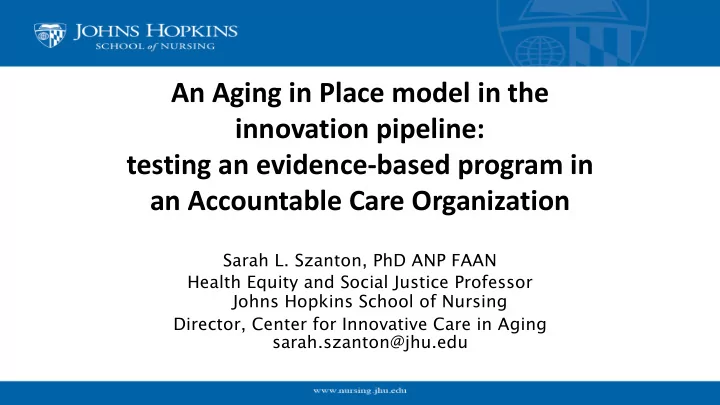

An Aging in Place model in the innovation pipeline: testing an evidence-based program in an Accountable Care Organization Sarah L. Szanton, PhD ANP FAAN Health Equity and Social Justice Professor Johns Hopkins School of Nursing Director, Center for Innovative Care in Aging sarah.szanton@jhu.edu
Acknowledgements: • Co- Authors: Judith Kell, Tonia Bourdon, James Purvis, Xuan Zhang, Laura Gitlin. • Funding: Trinity Health Innovations
CAPABLE Research Evidence Base- CAPABLE IMPROVES HEALTH OUTCOMES AND LOWERS COSTS MORE THAN 6X RETURN ON INVESTMENT Roughly $3,000 in program costs yielded more than $30,000 in savings in medical costs driven by reductions in both inpatient and outpatient expenditures. HALVED DIFFICULTIES IN FUNCTION Participants had difficulty with an average of 3.9 out of 8.0 Activities of Daily Living (ADLs) at baseline, compared to 2.0 after five months. REDUCED SYMPTOMS OF DEPRESSION Symptoms of depression, as well as the ability to grocery shop and manage medications also improved. IMPROVED MOTIVATION The change in physical environment further motivates the participant. Addressing both the people and the environment in which they live allows the person to thrive.
Person CAPABLE Team - At a Glance Person/Participant OT Handyman Self-assessment Functional/Mobility Receives work order; confers Readiness to change assessment with participant Goal setting – participant driven & Home risk; modifications & Obtains equipment, installs priorities set by participant equipment needs instruction/guidance for participant Brainstorming options/solutions; team in Fall prevention consultative role RN Work/actions to progress between each visit – Action Plan Active Medical history, current healthcare providers Exercises, education, practice listening, Absorb tips for safe independent living Key health issues/risks Interdisciplinary Pain, depression, medication communication review
Program Components Occupational Therapy – 6 visits; Nurse – 4 visits; Handyman – usually 2 visits CAPABLE Training, Skills Development, Forms, Action Plans, & Tools – Guide: rapport building, person-directed approach, progress tracking, fidelity to evidence-base, and evaluation
27 Implementation Sites
Early Adopter Experience • Variety of types of organizations involved as lead or in partnership: – Healthcare delivery system/ACO – Housing organizations – Meal/nutritional home delivery organization – Home health care agency – Other community-based social service agency • Able to secure start-up funding through grants, partnership, or self-funded • Successful pilot/initial experience – scaling up underway Additional agencies and organizations interested/exploring ways to support CAPABLE • implementation: – State Medicaid agencies – Medicare program
Study Design: • Prospective trial: CAPABLE (N= 100) with comparison to (N= 873) ACO patients with similar demographic indices • Site: Mercy Muskegon, MI site of Trinity Health. • Main outcomes: care utilization of CAPABLE participants the year before and the year after the program and in relation to those in ACO not served by CAPABLE.
Study Design: • Prospective trial: CAPABLE (N= 100) with comparison to (N= 873) ACO patients with similar demographic indices • Site: Mercy Muskegon, MI site of Trinity Health. • Main outcomes: care utilization of CAPABLE participants the year before and the year after the program and in relation to those in ACO not served by CAPABLE.
Population studied: • CAPABLE and ACO comparators were dually eligible for Medicaid and Medicare. • CAPABLE participants were 100 cognitively intact, community-dwelling adults ages 65 and older reporting difficulty with daily tasks such as bathing. • Mean (SD) age: 76.0 (9.0) • Average number of chronic conditions was 4.0 for both groups.
CAPABLE participants: fewer ED, hospital stays and 90 day readmissions post treatment. • Inpatient rates reduced from 23.0% in the year prior to receiving CAPABLE to 9.0% in the year after. • The participants who were readmitted prior to 90 days cost $6,920 less on average than they did prior to CAPABLE. • The comparison group of ACO patients did not change their rates of admission or cost. • The average CAPABLE participant reported a reduction in difficulty in seven daily activities assessed such as bathing, and dressing. Ninety percent of CAPABLE participants said they felt safer and more independent in their homes.
When used by CAPABLE participants, costs for these services were lower. • Inpatient rates reduced from 23.0% year prior to 9.0% year after. • Participants who were readmitted prior to 90 days cost $6,920 less on average than they did prior to CAPABLE. • Comparison group of ACO patients did not change their rates of admission or cost. • Average CAPABLE participant reported reduction in difficulty in seven daily activities such as bathing, and dressing. • 90% of CAPABLE participants felt safer and more independent in their homes.
Implications : • CAPABLE is being implemented in 27 places in 14 States but this is the first replication site to report cost results. • The reductions were lower than in initial CAPABLE program (of $30,000 over 2 years) but still saved more money than implementation cost. • This implementation of CAPABLE used fewer RN and OT visits and less handyman repair. • New adopters may calibrate their cost savings by the intensity of the intervention.
Policy Implications : • Medicaid waiver for older adults, • hospital admission reduction programs, • Medicare Advantage • ACOs • PTAC for Traditional Medicare
Conclusions: • Translating an evidence-based aging in place program was associated with reduced costs and disability among dually eligible older adults.
Leading the way in education, research and practice – locally and globally.
Recommend
More recommend